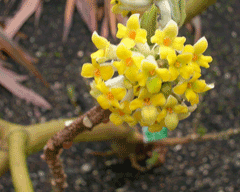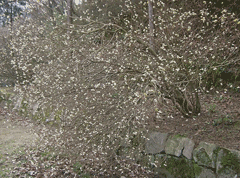 |
|
http://flickr.com/photos/93452909%40N00 |
 |
| http://commons.wikimedia.org/wiki/User:KENPEI |
Translate this page:
Summary
Physical Characteristics

 Edgeworthia chrysantha is a deciduous Shrub growing to 2 m (6ft) by 2 m (6ft).
Edgeworthia chrysantha is a deciduous Shrub growing to 2 m (6ft) by 2 m (6ft).
See above for USDA hardiness. It is hardy to UK zone 8 and is frost tender. It is in flower from February to April, and the seeds ripen from May to August. The species is hermaphrodite (has both male and female organs) and is pollinated by Insects.
Suitable for: light (sandy), medium (loamy) and heavy (clay) soils and prefers well-drained soil. Suitable pH: mildly acid, neutral and basic (mildly alkaline) soils. It can grow in semi-shade (light woodland) or no shade. It prefers moist soil.
UK Hardiness Map
US Hardiness Map
Synonyms
Plant Habitats
Woodland Garden Sunny Edge; Dappled Shade; Shady Edge;
Edible Uses
References More on Edible Uses
Medicinal Uses
Plants For A Future can not take any responsibility for any adverse effects from the use of plants. Always seek advice from a professional before using a plant medicinally.
Ophthalmic
The sliced root is used as a remedy for eye diseases[218].
References More on Medicinal Uses
The Bookshop: Edible Plant Books
Our Latest books on Perennial Plants For Food Forests and Permaculture Gardens in paperback or digital formats.

Edible Tropical Plants
Food Forest Plants for Hotter Conditions: 250+ Plants For Tropical Food Forests & Permaculture Gardens.
More

Edible Temperate Plants
Plants for Your Food Forest: 500 Plants for Temperate Food Forests & Permaculture Gardens.
More

More Books
PFAF have eight books available in paperback and digital formats. Browse the shop for more information.
Shop Now
Other Uses
Paper String
A high-class paper is made from the bark[1, 11, 58, 61]. The bark fibres are used[61]. The stems are harvested in spring or early summer, the leaves are removed and the stems steamed until the fibres can be stripped. The outer bark is removed from the inner by peeling or scraping. The fibres are cooked for 2 hours with soda ash and then beaten with mallets or put through a blender. The paper is off white in colour[189]. The stems are extremely supple and can be tied in knots[11, 182].
Special Uses
Scented Plants
References More on Other Uses
Cultivation details
Succeeds in any soil in sun or part shade[175, 184, 200], growing well in light woodland[200]. Prefers a well-drained soil with plenty of moisture in the growing season[1, 200]. This species is hardy to about -15°c according to one report[184], though others say that it is only hardy in the milder areas of Britain[1, 11]. It succeeds on a wall at Kew[K] and as a free-standing shrub in Cornwall[11]. The plant is frost hardy, but the flowers are susceptible to frost damage[188]. The plant is best grown on a south or west-facing wall[188]. Plants resent root disturbance and should be put into their permanent positions as soon as possible[188]. This species is cultivated in Japan for the paper that can be made from the bark[1, 11, 109]. The stems are harvested every second year[61]. This species is very closely related to and scarcely distinct from E. gardneri and E. papyrifera[200]. The flowers diffuse a pronounced clove-like perfume and will scent the air to some distance on a calm day[245].
References Carbon Farming Information and Carbon Sequestration Information
Temperature Converter
Type a value in the Celsius field to convert the value to Fahrenheit:
Fahrenheit:
The PFAF Bookshop
Plants For A Future have a number of books available in paperback and digital form. Book titles include Edible Plants, Edible Perennials, Edible Trees,Edible Shrubs, Woodland Gardening, and Temperate Food Forest Plants. Our new book is Food Forest Plants For Hotter Conditions (Tropical and Sub-Tropical).
Shop Now
Plant Propagation
Seed - best sown as soon as it is ripe in a cold frame. Place the pot in a plastic bag to keep it moist[175]. The seed might germinate in the spring, though it could take another 12 months. Stored seed usually requires 8 - 12 weeks warm stratification at 20°c followed by 12 - 14 weeks at 3°c[175]. Germination can still take 12 months or more at 15°c[175]. Prick out the seedlings into individual pots as soon as they are large enough to handle, and grow on in a greenhouse for at least a year before planting out in late spring or early summer[175]. Consider giving the plants some protection from the cold for their first winter outdoors. Cuttings in spring. Cuttings of half-ripe wood, July/August in a frame[200].
Other Names
If available other names are mentioned here
Native Range
TEMPERATE ASIA: China (Fujian Sheng, Guangdong Sheng, Guangxi Zhuangzu Zizhiqu, Guizhou Sheng, Henan Sheng, Hunan Sheng, Jiangxi Sheng, Yunnan Sheng, Zhejiang Sheng)
Weed Potential
Right plant wrong place. We are currently updating this section.
Please note that a plant may be invasive in one area but may not in your area so it's worth checking.
Conservation Status
IUCN Red List of Threatened Plants Status :

Growth: S = slow M = medium F = fast. Soil: L = light (sandy) M = medium H = heavy (clay). pH: A = acid N = neutral B = basic (alkaline). Shade: F = full shade S = semi-shade N = no shade. Moisture: D = dry M = Moist We = wet Wa = water.
Now available:
Food Forest Plants for Mediterranean Conditions
350+ Perennial Plants For Mediterranean and Drier Food Forests and Permaculture Gardens.
[Paperback and eBook]
This is the third in Plants For A Future's series of plant guides for food forests tailored to
specific climate zones. Following volumes on temperate and tropical ecosystems, this book focuses
on species suited to Mediterranean conditions—regions with hot, dry summers and cool, wet winters,
often facing the added challenge of climate change.
Read More
Expert comment
Author
Lindl.
Botanical References
11200266
Links / References
For a list of references used on this page please go here
Readers comment